The surface raiders: The German Imperial Navy actions during WW1 were four-fold: The main navy (Hochseeflotte) protecting the homeland but forced to a relative inaction because of the opposing Royal Navy, the overseas squadrons (Souchon or Graf Spee’s Pacific squadron and other local forces) chased down by the allies at the beginning of the war, U-boats, that soon became the main threat to British commerce, and at last, German surface commerce raiders.
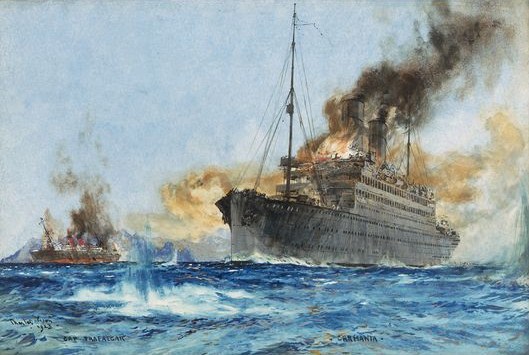
Carmania sinking Cap Trafalgar off Trinidad, September 14, 1914
In a sense, German cruisers already played that role of commerce raiding in 1914 Emden and Dresden being the most succesful. But at the same time, and until 1916, civilian ships captured or seized and converted as commerce raiders succeeded in sinking or capturing sometimes dozens of ships, making this kind of warfare valuable. The two most successful were the Möwe, Wolf and tall ship Seeadler.
However others were sunk at their first sortie. Early on also, the German admiralty did not trusted these ships to wage war and used them as disguised minelayers, with success. In some ways, the Königin Luise was the first of them. In any case, they are lesswell known known that their successors, the WW2 German Commerce Raiders, often better armed and more successful, that is, until WW1 centennial make them rise again from memory. Some of their feats of seamanship are just staggerring. These are stories to be told.
1st phase of German commerce warfare: Liners
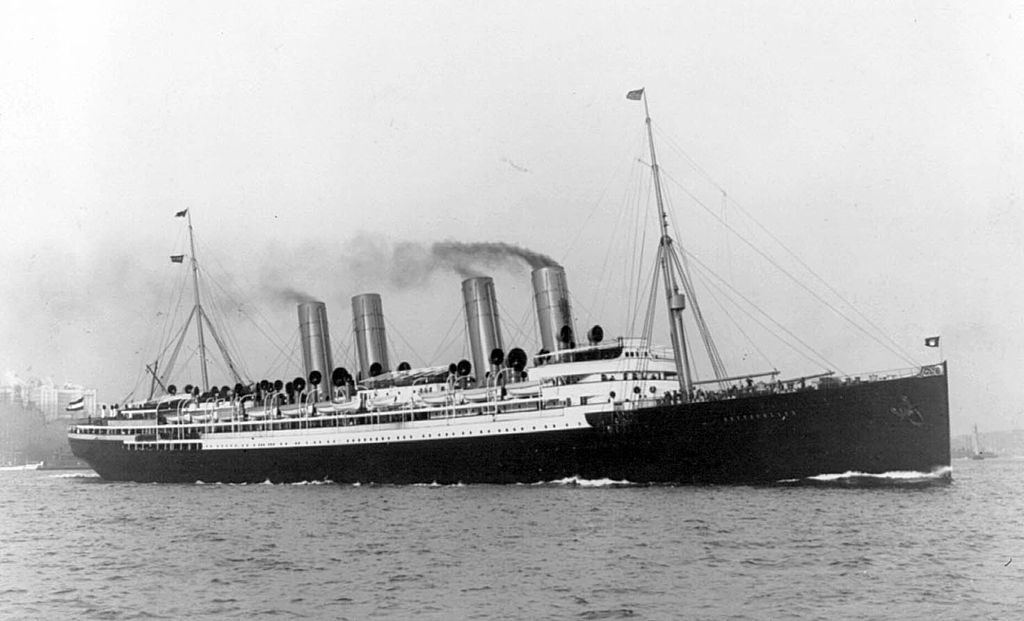
SS Deutschland, future SMS Victoria Luise
Converted Commerce raiders had been employed since the American civil war and auxiliary cruisers (ie armed passenger liners) since the Russian ‘Volunteer Fleet’ of the Russo-Japanese war.
In the Second Hague Conference of 1907 one of the declarations referred to the Conversion of merchant vessels to auxiliary cruisers. Following this
general international acceptance of commerce raiders the Imperial German Government asked prominent German shipping companies to fit their new liners with the necessary preparations (such as strengthened positions for guns) which would allow rapid conversion in wartime.
The Möwe at sea (footage)
According to this general belief in the value of converted passenger liners as commerce raiders, we find those ships in action in the opening period of the First World War. Apart from the liners described and listed in this section the liner Kronprinzessin Cecilie of the Nord-deutscher Lloyd and the Imperial Mail liner Lützow were scheduled for conversion, but the first ship returned to New York, where she was interned, and the second was trapped in the Suez Canal when war broke out.
Equipment of these liners by overseas cruisers or obsolete station guardships followed a well prepared mobilisation programme. Although a well arranged supply organisation had been prepared and brought into service, the concept of passenger liners as commerce ahd failed: these ships always provoked suspicion and their superior
speed was offset by an immense need for coal.
2nd phase of German commerce warfare: Cargos
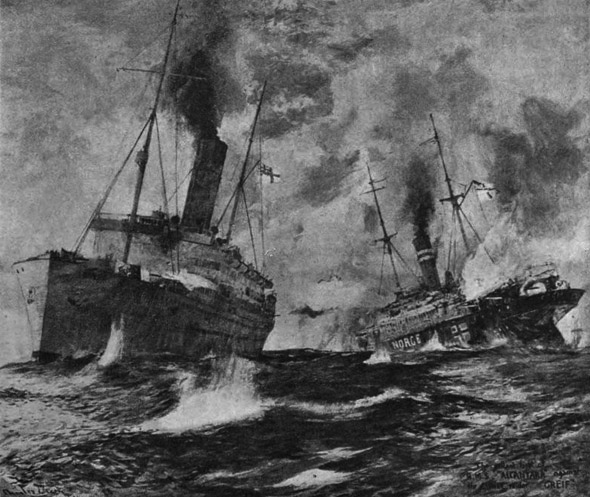
SMS Greif duelling with HMS Alcantara, 1916
In the second period the Germans started to convert ordinary cargo vessels, but with the principal role of disguised auxiliary minelayers: They were not allowed to start active raiding until they had discharged this duty.
By the autumn of 1915 a young Lieutenant, Theodor Wolff, had written a well-considered memorandum that was to presage the most successful aspects of commerce raiding in both world wars. He developed the theory of the disguised freighter acting as a wolf in sheep’s clothing – a concept made familiar by the successful later German commerce raiders. The first ship of this second wave was the Möwe, although the German Admiralty still insisted that she should lay her mines first.
A gift for propaganda: Romantic deeds of modern swashbucklers
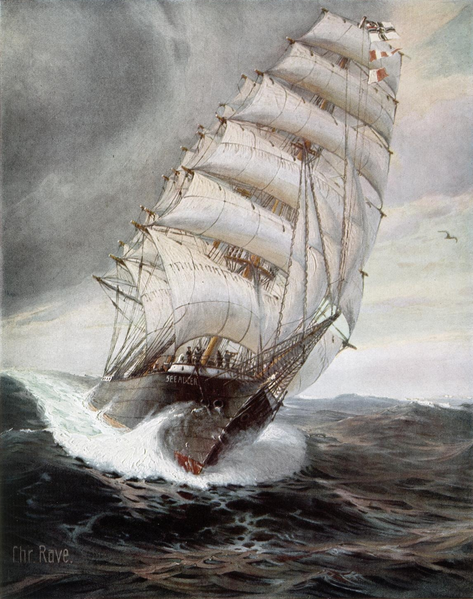
A more adventurous side issue of German raider warfare was the employment of a full-rigged sailing ship (the SMS Seeadler) and post-war publicity and literature mirrors the high public interest in this romantic type of warfare. The Seeadler and the personality of her captain, Felix von Luckner aka “The Kaiser’s pirate” were much to praise here.
Far from the image of murderous brute applied to the German war machine in Belgium, this was the image of a courteous, chivalrous, bloodless and hate-less way to wage war: Against goods and assets and not men which were treated on board “like friends”, bound by the fraternity of sailors.
It was a brillant concept using a sailing ships as the most inoffensive predator imaginable. And the Seeadler roamed the Atlantic, north to south, and Pacific, for 225 days capturing 15 ships. SMS Seeadler was eventually cornered and found refuge in French Polynesia, was stranded on a reef at Mopelia, near Tahiti. The crew then escaped with a schooner.
German commerce raiders in detail
Cold case: Comparing the successes of German commerce raiders of both world wars, the only significant point is the growth in size of the average merchant vessel within_two decades: First World War, 103 vessels totalling 357,894grt; 129 vessels totalling 772,633grt in the Second.
SMS ILTIS
Iltis was the former British merchant ship Turitella, built in 1905 and captured by the German commerce raider Wolf on 27 January 1917. The Turitella was the former German Gutenfels, seized by the British at Alexandria when war broke out.
As a ship of the ‘-fels’ type she was a sistertship of the Wolf (ex-Wachtfels). She was quickly armed and received some mines and was used as a disguised minelayer. She laid her mines in the entrance to the HMS Aden and scuttled herself to avoid being captured by the British cruiser HMS Fox, on 15 March 1917.
Dimensions: 135.2 x 6.97 x 6.1m (443ft 6in x 55ft 6in x 2ft)
Machinery: 1-shaft VTE, 260ihp top speed 11kts
Armament: 1x 52mm, 25 mines (from Wolf)
Complement: 74
SMS Geier
Geier was the former British merchant vessel Saint Theodore (1913), captured by the commerce raider Möwe on 12 December 1916. She was armed by the Möwe and commissioned in her new role on 14 January 1917. She sank two sailing ships totalling 1442grt. On 14 February 1917 she was scuttled by the Möwe because of her worn out machinery.
SMS LEOPARD
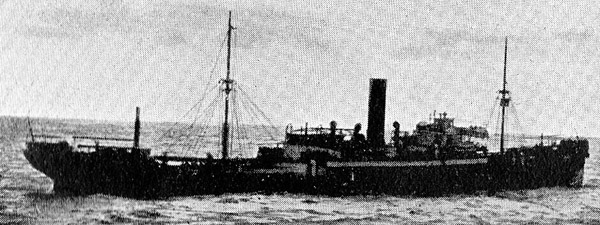
SMS Leopard was the former British merchant vessel Yarrowdale, built in 1912 and captured by the commerce raider Möwe on 11 December 1916. She was sent to Germany, equipped as a raider and comissionned in her new role on 9 January 1917. She was sunk during her breakout into the Atlantic, on 16 March 1917.
https://en.wikipedia.org/wiki/SMS_Leopard_(1912)
Displacement: 9800t; 4652grt
Dimensions: 124.7m >< 15.8m x 7.4m (409ft 1in x 42ft x 24ft 3in)
Machinery: l-shaft VTE, 240 ihp = 13kts
Armament: 5-15cm (5.9in) SKL/40, 4-8.8cm (3.45in) SKL/40, 2-50cm (19.7in) TT
Complement: 319
WOLF (i)
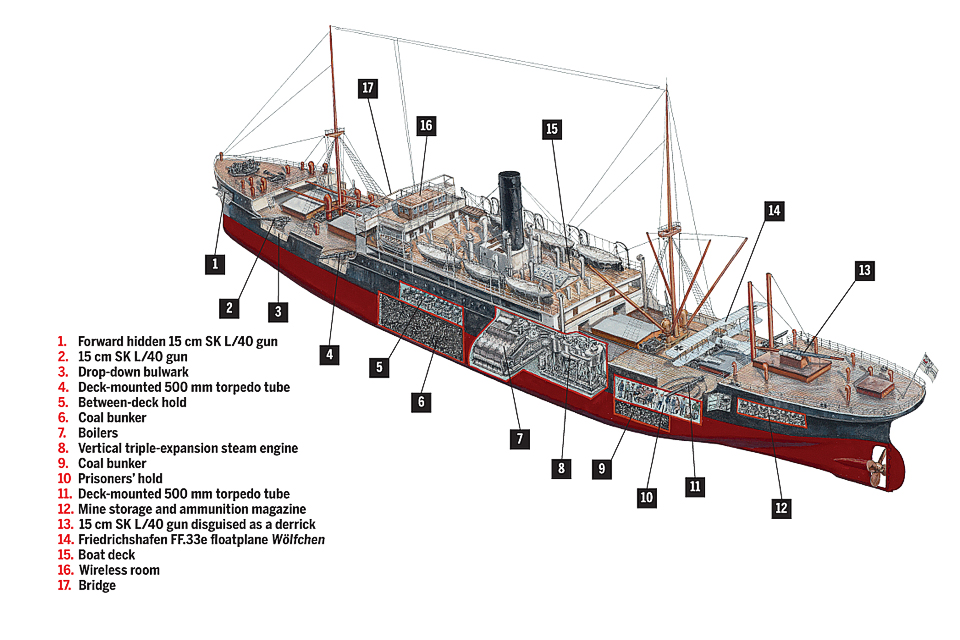
SMS Wolf cutaway – From history.net
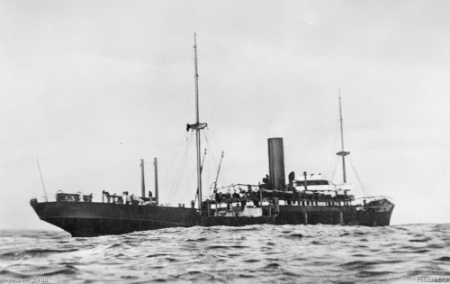
Wolf (i) was the former British merchant vessel Belgravia, built in 1906 at Workington and selzed after the outbreak of war at Hamburg.
The ship was commissioned as a raider on 14 January 1916 but ran aground during her first some in the Elbe estuary (26 February 1916). She was so heavily damaged that she was decommissioned; she was ceded to France in 1919.
Displacement: 12,900t; 6648grt
Dimensions: 141.1 x 16.2 x 7.8m (462ft llin x 53ft 2in x 25 ft 7in)
Machinery: 1 shaft VTE, 4 boilers 3300 ihp = 13 knots
Armament: 4-15cm (5.9in) SLK/40, 2-37 mm, 2-50cm (19.71n) TTs
Complement: 361
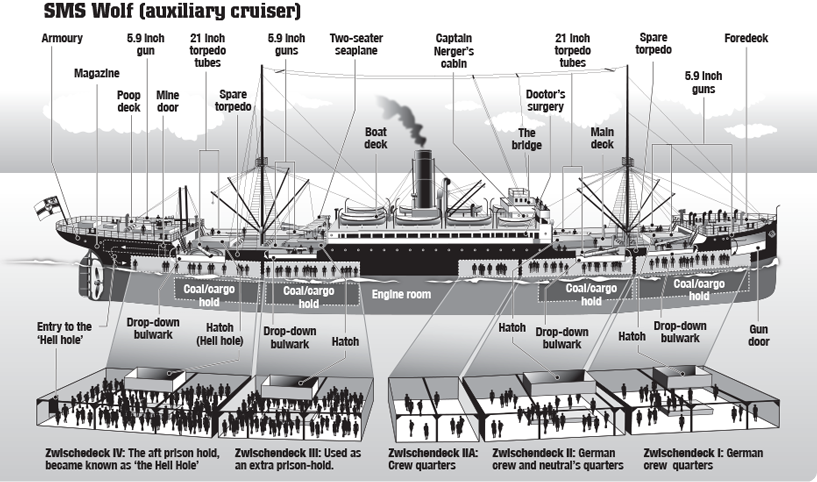
SMS Wolf captured crew holds – from weaponsandwarfare.com
Wolf II
Wolf (ii) was the former merchant ship Wachtfels, built in 1913 at the Fleas-burger Schiffbau-Gesellschaft and commissioned in her new role on 16 May 1916. Following German commerce warfare policy she had first to lay her mines before being allowed to start active raiding.
As a novelty in raider warfare she was the first such German ship to have a spotting seaplane on board (a Friedrichshafen E 33); she also carried 3-52mm to arm auxiliaries.
She laid her first 25 mines off Cape Town on 16 January 1917, and the rest off Colombo. During her active raiding career she captured 14 ships totalling 38,391grt, including the prize Turritella, which was temporarily commissioned as the raider I (SMS Iltis) his to mine Aden. She managed to return unhindered to Gemany, served in the Baltic and was turned over to France in 1919. Renamed Antinous she served until 1931 when she was scrapped.
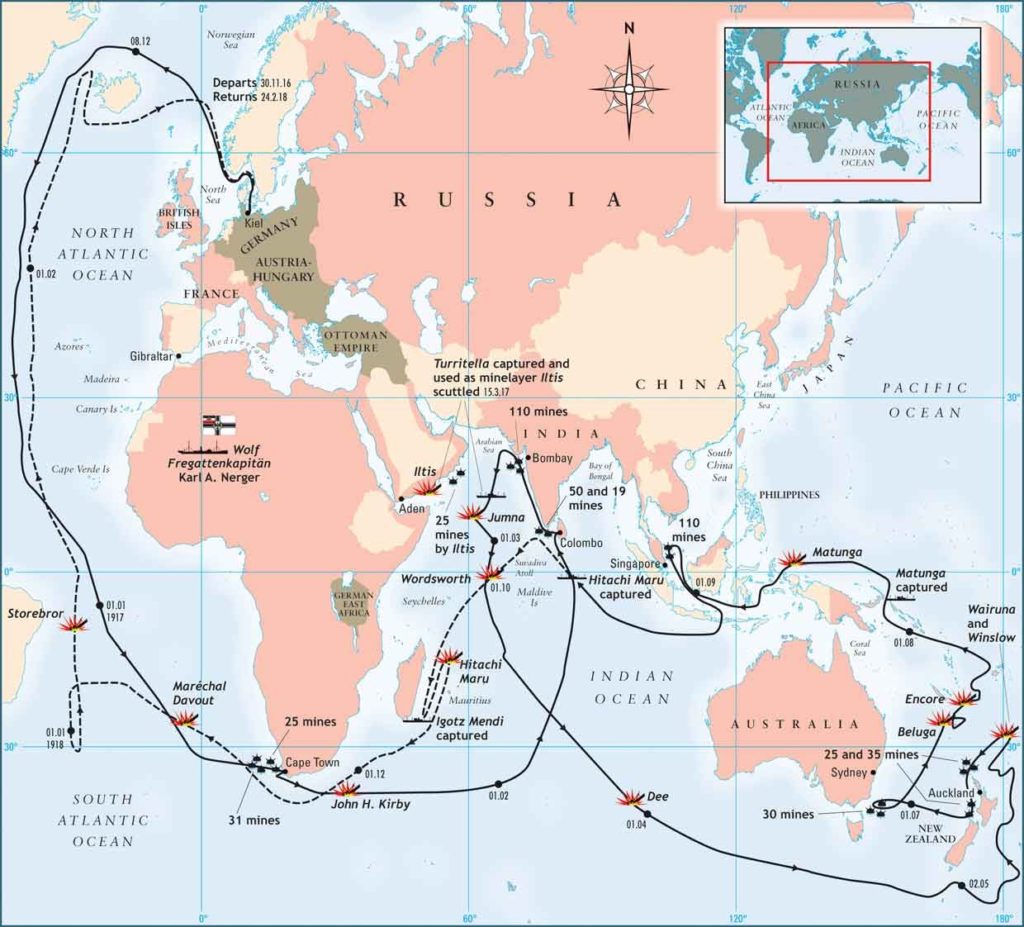
SMS Wolf (II) Rampage across several oceans. From weaponsandwarfare.com
Displacement: 11,200t 5809grt
Dimensions: 135m >< 17.1m x 7.9m (442ft llin x 56ft lin x 25ft llin)
Machinery: 1-shaft VTE, 3 boilers, 280ihp = 10.5kts
Armament: 7-15cm (5.9in) SKL/40, 4-5ocm (19.7in) TT, 465 mines 1 seaplane
Crew: 347
SMS GREIF
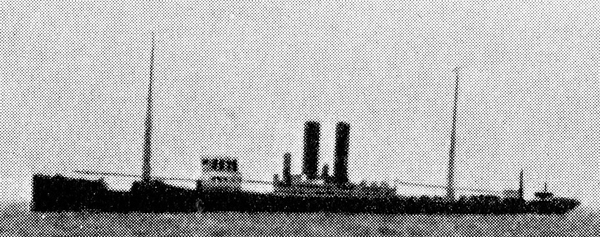
Greif was the former 4,962 GRT steel-hulled mercantile Guben, built in 1914 at Neptun, Rostock for the German-Australian Line (DADG), Hamburg. She was converted for naval service at Kaiserliche Werft Kiel in 1915 and was commissioned on 23 January 1916. She sailed from the Cuxhaven (Elbe) under orders of Fregattenkapitän Rudolf Tietze.
But she was intercepted during her first sortie in the North Sea on 29 February 1916. The Royal Navy indeed intercepted and decoded messages, allowing to ambush her with the British AMC HMS Alcantara off Norway, as the German corsair was disguised as the Norwegian Rena bound for Tønsberg.
The 15,620 GRT armed merchant cruiser Alcantara catch her on the morning of 29 February 1916, closed to engage her with her six 6-inch (150 mm) guns and two 3-pounders when the German ship revealed herself, raising the German battle ensign and opening fire while speeding.
After an epic duel at less than 3000 yards bith ships exchanged volleys. One hit on the Greif destroyed the aft gun after exploding the ready-round ammunition. Other hits gradually reduced their speed but Alcantara eventually sank first after being hit by a torpedo amidships on her port side. But this was not before she called for help.
Soon, AMC Andes, protected cruiser HMS Camus and two destroyers were on her heels. and sank her. Greif’s crew abandoned ship 40 minutes after the start of the duel just when the C-class light cruiser HMS Comus and M-class destroyer HMS Munster arrived and took the Greif as target. They also rescued 120 German survivors, while 187 Germans perished and 72 British sailors.
Displacement: 9900t; 4962grt
Dimensions: 131.7m x 16.4m x 7.5m (432ft x 53ft 1ft x 24ft 8in)
Machinery: l-shaft VTE, 2 boilers, 3000 ihp = 13kts
Armament: 4-15cm (5.9in) SKL/40, 1-10.5cm (4.1in) 2-50cm (19.7in) TTs
Complement: 307
SMS Möwe

Author’s illustration
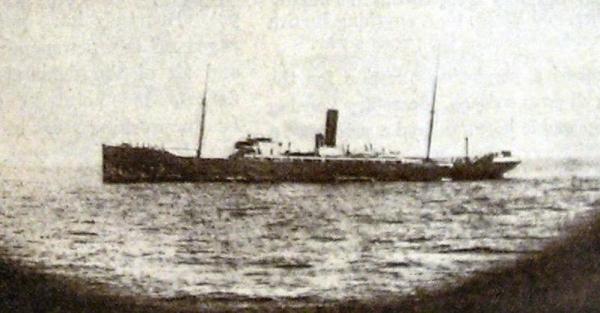
By far the most famous commerce raider of WW1, the Möwe (seagull)’s own legend is on par with SMS Seeadler and SMS Emden. Her rampage started with laying mines, then a first sortie through the channel, down to the Portuguese coast, sinking and capturing 16 allied ships and returning safely in Wilhelmshaven for her first trip. That was only the beginning.
Möwe was the former banana carrier Pungo of the Laeisz Line, built by I C Tecklenborg AG, Wesermfinde and launched in 1914. The brand new ship was to become the most successful German raider of the First World War.
A role for which she was commissioned on 1 November 1915. She made two sorties, in the first achieving 15 ships sunk (totalling 57,52ogrt), and in the second 25 ships of 125,265grt. Between these two sorties she saw service as the commerce raider Vineta (not to be confused with the ex-Cap Polomol) in the Baltic, capturing one ship of 3326grt.
After her lucky cruiser she returned to serve as the auxiliary mining vessel Oslsee, became a British war reparation and served under the name Greenbeer. In 1933 she was sold to Germany and renamed Oldenburg, but on 7 April 1945 she was torpedoed by a British submarine off Norway, beached, and after the war in 1953 recovered and scrapped.
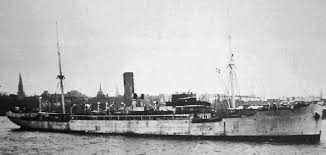
SMS Möwe, date unknown. One of her mines possibly sank the British battleship HMS King Edward VII in the north sea
Dimensions: 123.7 x 14.4m x 7.2m (405ft mm x 47ft 3in x 23ft 7in)
Machinery: l-shaft VTE, 5 boilers, 3200ihp = 13.3kts
Armament: 4-15cm (5.9in) SKL/45 1-10.5 cm (4.1in) SKL/45, 2-50cm TTs (19.7 in)
Complement: 234
The Great war Channel special: The Möwe
SMS Meteor
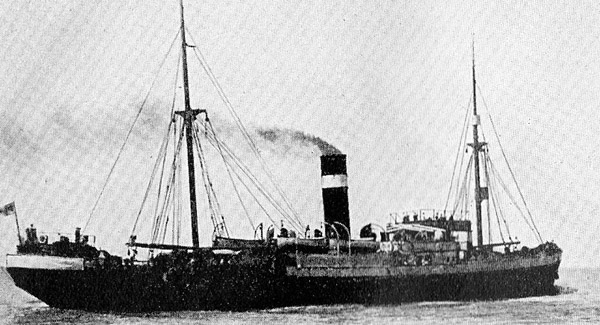
Meteor was the former British merchant vessel Vienna, built in 1903 by Ramage & Ferguson, of Leith, for Curries shipping line. She seized at Hamburg when the war broke out.
Because of her unsuspicious silhouette, unmistakably British appearance and the reduced belief in the efficacy of commerce warfare during this period, she served as a disguised minelayer and auxiliary cruiser off British North Sea harbours.
She has been refitted at Kaiserliche Werft (KWW) in Wilhelmshaven, with two 88 mm guns and two machine guns, plus minelaying equipment and capacity for 347 mines. She was commissioned in May 1915 as SMS Meteor, but she never captured any merchant vessel during her first sortie under the command of KK Wolfram von Knorr.
She layed mines in the White Sea and attacked Allied merchant ships bound to Russia. Sha sank three freighters by gunfire and claimed three others by mines. She returned unharmed in June 1915. During her second sortie, on 9 August 1915, she laid mines in the Moray Firth (she only sank a Danish sailing ship).
While attempting to run the British blockade she caught the attention of British armed boarding vessel HMS Ramsey, that she sank by surprise after a boarding party was sent.
The gunfire draw attention of the nearby cruisers and she quackly intercepted by British cruisers and scuttled herself on 9 August 1915, While the crew returned to Germany on board a Swedish fishing boat.
SMS Vineta

Profile rendition of SS Vineta (from navypedia.org)
Vineta was the former Cap Polonio, a passenger liner of the Hamburg Suedamerikanische Dampfschiffahrts-Gesellschaft, built by Blohm & Voss of Hamburg and launched in March 1914.
The ship was not commissioned at the outbreak of the war and was to have replaced the Berlin, which was now interned in Norway. She had for the first time on a German merchant vessel water-tube boilers with forced draught.
To produce enough steam to obtain the desired 18-l9kts the best British coal would have been necessary, which was of course impossible during wartime. Trials showed that she could make only 16.9kts and was therefore an inferior opponent to the fast British turbine-powered AMCs.
During the war she was laid up in Hamburg, then came as a war reparation to Great Britain, and was resold to her old owners in 1921.
Displacement: 24,500t; 20,576grt
Dimensions: 201.87m x 22.1m x 8.4m(662ft lin x 72ft 6in x 27ft 7in)
Machinery: Z-shaft VTE, 14 boilers, 16,00ihp: 16.9kts
Armament: 4-l5cm (5.9in) SKL/40, 4-8.8cm (3.45in) SKL/4S
SMS Berlin
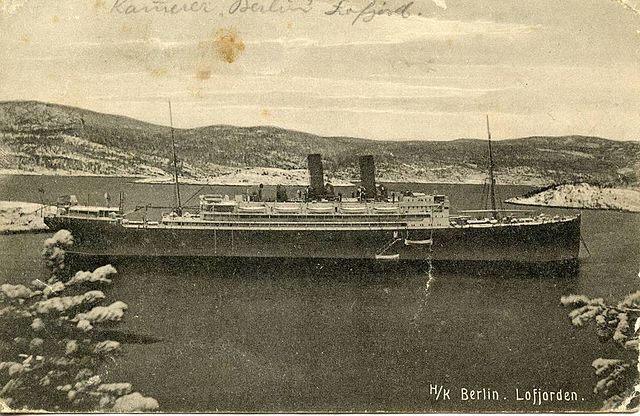
SS Berlin, interned in Norway (postcard).
A former passenger liner of Norddeutscher Lloyd, built in 1908 at the AG Weser yard, Bremen, she was converted to a minelayer and auxiliary cruise: and commissioned in her new role on 28 September 1914.
The priorities for her first sortie were: 1) laying mines off the British East Coast; 2) the interception and capture of British fishing vessels; and 3) commerce raids. This unlucky ship, commanded by a captain psychologically unsuited for this job, had only one success in her first role: on 27 October 1914 HMS Audacious hit one of Berlin’s mines and sank with all hands.
The Berlin could not fulfil her second duty due to heavy gales. During the attempt to approach a British freighter, the German captain decided that the raider had been recognised and cancelled the attack. Believing that he was now hunted by British North Sea Forces and that he had not enough coal to reach Germany he decided to intern the shlp in Norway.
On 18 November 1914, she entered Trondheim and was interned for the rest of the war. After the war she came to England as a war reparation and served the White Star Line under her new name Arabic until 1931.
Dimensions: 186m x 21.3m x 8.6m (610ft 3in x 69ft 1in x 28ft 3in)
Machinery: 2-shaft VTE, 7 boilers, 14,000ihp = 16.5kts
Armament: 2-10.5cm (4.1in) SKL/40, 6-37mm
SMS Cap Trafalgar
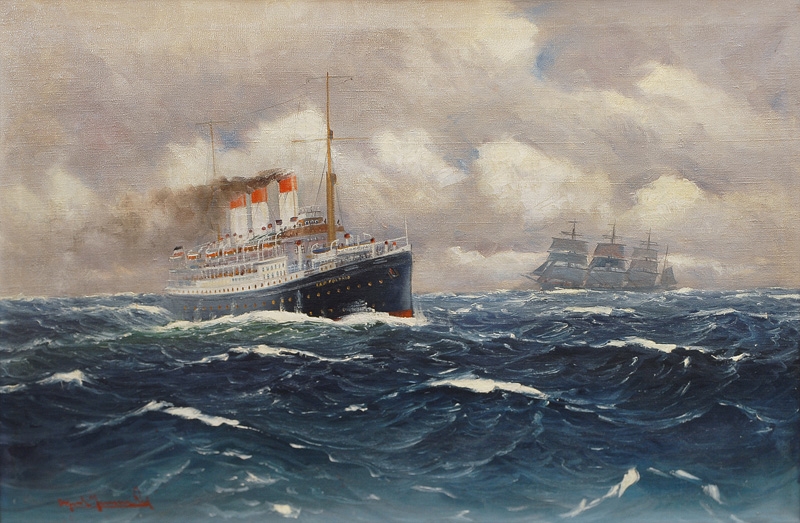
A liner of the Hamburg Suedamerikanische Dampfschiffahrts-Gesellschait built by Vulcan, Hamburgfind launched in March 1914. The brand new ship served on the South America route and was at Buenos Aires when war broke out.
She was armed by the obsolete German gunboat Eber which sailed from German South West frica and then went to Bahia, Brazil for interning. Cap Trafalgar was commissioned in her new role on 31 August 1914.
She was however intercepted on 14 September 1914 in the vicinity of Trinidad, by the AMC Carmania; she was sunk after an unequal artillery duel.
Dimensions: 186m x 21.9m x 8,3m (610ft 3in x 71ft 1oin x 27ft 3in)
Machinery: 2-shaft DE, 14 boilers, 3000? ihp top speed 18kts
Armament: 2-10cm (4.1in) SKL/35, 4-37mm
Complement: 319
SMS Cormoran (1909)
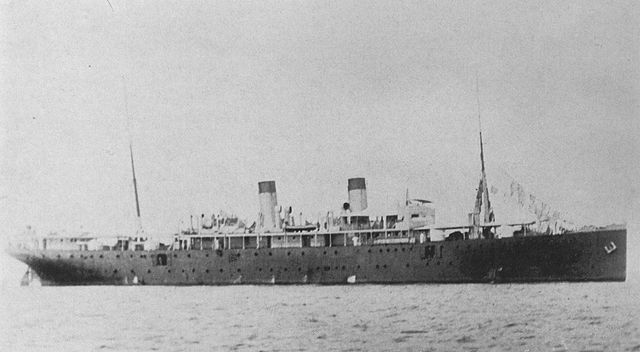
Originally built at Schichau, Elbing for the ‘Russian Volunteer Fleet’ as the auxiliary cruiser Rjäsan, the ship was captured en route to Vladivostok on 4 August 1914 by the German light cruiser Emden.
Having emplacements for guns she was dispatched to the German colony of Tsingtao to be armed with the guns of the old German cruiser Cormoran, also receiving her name and being manned with the Cormoran’s crew.
She was commissioned in her new role on 7 August 1914. Running out of coal and provisions she was interned at Guam on 13 December 1914; on 7 April 1917 she was scuttled by her crew, before being seized by US forces, probably the only German commerce raider to be so by US Forces.
SMS KRONPRINZ WILHELM
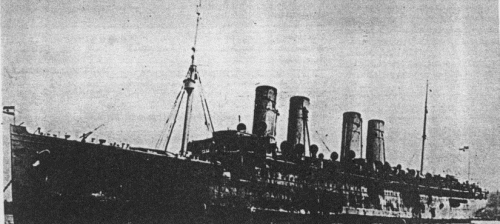
A passenger liner of the Norddeutscher Lloyd, launched by Vulcan, Stettin, she was a near sister of the Kaiser Wilhelm der Grosse and won the “blue ribbond” in 1902 while serving on the North Atlantic route.
She left New York and was armed at sea by the light cruiser Karlsruhe but had no ammunition for her 12cm guns. On 6 August 1914 she was commissioned in her new role. Operating in the Atlantic she captured 15 ships, totalling 60.552 grt.
Running out of supplies and coal she was intened at New port News 26 April 1915. When the USA declared wa on 7 April 1917 she was seized and under the new name Von Steuben she served as an US Navy troop transport. She was scrapped in 1923.
https://en.wikipedia.org/wiki/SS_Kronprinz_Wilhelm
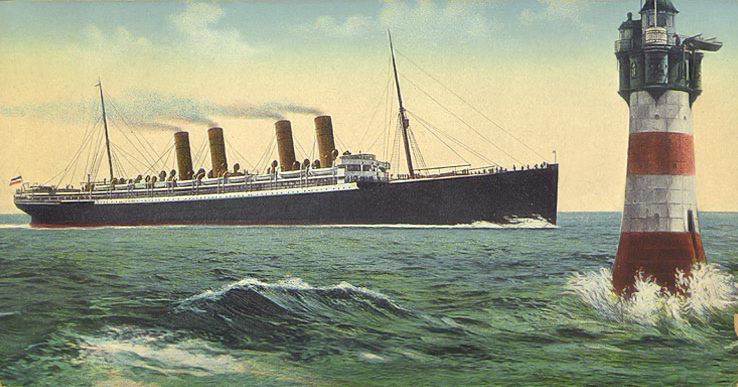
Displacement: 24,900t;14,908t
Dimensions: 202.2m >< 20.2m x 8.5m (663ft 4in x 66ft 3in x 27ft 1in)
Machinery: 2-shaft VTE, 16 boilers, 36,000ihp top speed 23kts
Armament: 2-12cm (4.7in), 2-8.8cm (3.45in)
Complement: 467 + 36
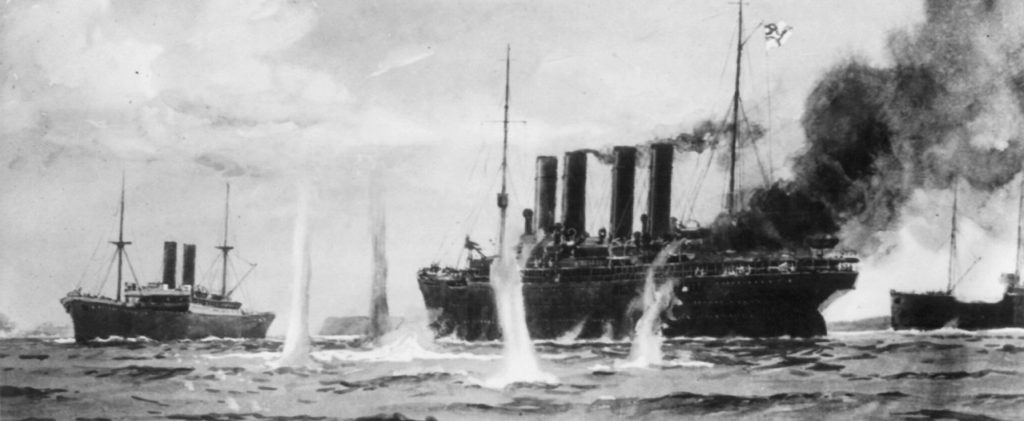
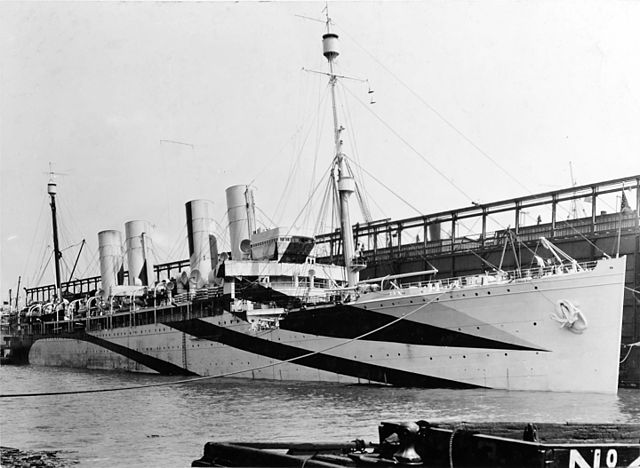
Kronprinz as USS Von Steuben, 1917
SMS PRINZ EITEL FRIEDRICH
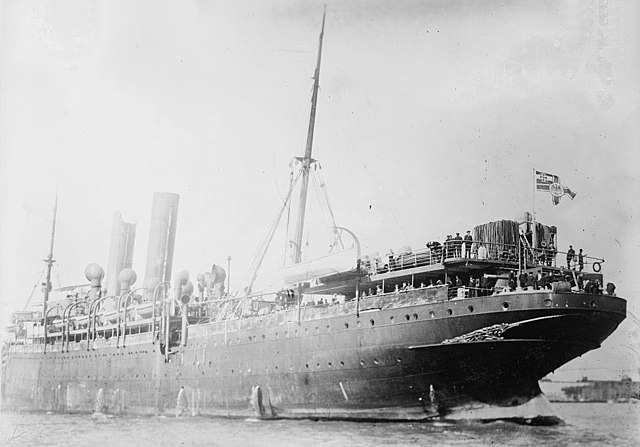
SS Prinz Eitel Friedrich showing her port gun aft
Launched 10 June 1904 by Vulcan, Stettin, she was a former passenger liner of the Norddeutscher Lloyd. She served on the Far East route, and when war broke out was en route from Japan to Shanghai, with her mobilisation orders.
She was sent to Kiautchou where she received the guns of the obsolete gunboats Luchs and Tiger manned by their respective crews. On 5 August 1914 she was commissionned in her new role, operating with SMS Cormoran in Australian waters.
Because of a coal shortage she crossed the Pacific, joined Graf Spee’s East Asian Squadron for a short time, rounded Cape Horn and operated in the South Atlantic.
There, she captured 11 ships totalling 33,423grt, but running low on coal and due to the worn out condition of her machinery, she entered Newport News in the US for interning on 9 April 1915. When the USA declared war on Germany, the liner was impressed into the US fleet as the troop transport De Kalb on 7 April 1917 and after the war she served under her new name Mount Clay for the United America Lines, scrapped in 1927.
During her career she captured 4 French, 5 British, a Russian and an American ships, totalling 33,423 tons grt.
Displacememt: 16,000t, 8,797grt
Dimensions: 153.37 x 16. x 7.1m (502ft llin x 55ft 5in x 23ft 4in)
Machinery: 2 shaft VTE, 4 boilers, 7000ihp = 15kts
Armament: 4-10.5cm (4.1in), 6-8.8cm (3.45in), 4-37mm
Complement: 402
SMS KAISER WILHELM DER GROSSE

Conway’s profile, SMS Kaiser Wilhelm der Grosse
A passenger liner of the Norddeutscher Lloyd and winner of the ‘blue ribband’ in November 1897, she was launched on 4 May 1897 by Vulcan, Stettin. She was commissioned as flagship of the NDL on 9 September 1897 and served on the North Atlantic route.
Being in Germany when war broke out she was converted to a commerce raider according to her mobilisation role, was commissioned on 2 August 1914 and operated in the northern and mid-Atlantic.
She was attacked during a coaling operation in the neutral waters of the Spanish North African colony of Rio de Oro on 26 August 1916 by the British cruiser HMS Highflyer, and was scuttled and capsized. She had captured 3 ships totalling 10,683 grt.
Displacement: 24,300t; 14,349grt
Dimensions: 198m wl, 199.5m oa x 20.1m x 8.4m (649ft 7in wl x 654ft 6in 03 x 65ft 11in x 27ft 7in)
Machinery: 2-shaft VTE, 14 boilers, 28,000ihp = 22.5kts
Armament: 6-10.5cm (4.1in), 2-37mm
Complement: 584
*Cover picture: SS Kaiser Wilhelm der grosse epic duel with HMS Highflyer
Src, Read More
German commerce raiders WW1
ebay.com/ New-Vanguard German Commerce Raiders 1914-18 by Ryan K. Noppen 2015
navypedia.org German AMCs
List of auxiliary and merchant cruisers
google Books list of auxiliary and merchantmen 1914-1918 The cross of sacrifice by DD Jarvis
About the SMS Möwe
Conway’s all the world’s fighting ships 1906-1921


 Latest Facebook Entry -
Latest Facebook Entry -  X(Tweeter) Naval Encyclopedia's deck archive
X(Tweeter) Naval Encyclopedia's deck archive Instagram (@navalencyc)
Instagram (@navalencyc)





 French Navy
French Navy Royal Navy
Royal Navy Russian Navy
Russian Navy Armada Espanola
Armada Espanola Austrian Navy
Austrian Navy K.u.K. Kriegsmarine
K.u.K. Kriegsmarine Dansk Marine
Dansk Marine Nautiko Hellenon
Nautiko Hellenon Koninklije Marine 1870
Koninklije Marine 1870 Marinha do Brasil
Marinha do Brasil Osmanlı Donanması
Osmanlı Donanması Marina Do Peru
Marina Do Peru Marinha do Portugal
Marinha do Portugal Regia Marina 1870
Regia Marina 1870 Nihhon Kaigun 1870
Nihhon Kaigun 1870 Preußische Marine 1870
Preußische Marine 1870 Russkiy Flot 1870
Russkiy Flot 1870 Svenska marinen
Svenska marinen Søværnet
Søværnet Union Navy
Union Navy Confederate Navy
Confederate Navy Armada de Argentina
Armada de Argentina Imperial Chinese Navy
Imperial Chinese Navy Marinha do Portugal
Marinha do Portugal Mexico
Mexico Kaiserliche Marine
Kaiserliche Marine 1898 US Navy
1898 US Navy Sovietskiy Flot
Sovietskiy Flot Royal Canadian Navy
Royal Canadian Navy Royal Australian Navy
Royal Australian Navy RNZN Fleet
RNZN Fleet Chinese Navy 1937
Chinese Navy 1937 Kriegsmarine
Kriegsmarine Chilean Navy
Chilean Navy Danish Navy
Danish Navy Finnish Navy
Finnish Navy Hellenic Navy
Hellenic Navy Polish Navy
Polish Navy Romanian Navy
Romanian Navy Turkish Navy
Turkish Navy Royal Yugoslav Navy
Royal Yugoslav Navy Royal Thai Navy
Royal Thai Navy Minor Navies
Minor Navies Albania
Albania Austria
Austria Belgium
Belgium Columbia
Columbia Costa Rica
Costa Rica Cuba
Cuba Czechoslovakia
Czechoslovakia Dominican Republic
Dominican Republic Haiti
Haiti Hungary
Hungary Honduras
Honduras Estonia
Estonia Iceland
Iceland Eire
Eire Equador
Equador Iran
Iran Iraq
Iraq Latvia
Latvia Liberia
Liberia Lithuania
Lithuania Mandchukuo
Mandchukuo Morocco
Morocco Nicaragua
Nicaragua Persia
Persia San Salvador
San Salvador Sarawak
Sarawak Uruguay
Uruguay Venezuela
Venezuela Zanzibar
Zanzibar Warsaw Pact Navies
Warsaw Pact Navies Bulgaria
Bulgaria Hungary
Hungary

 Bundesmarine
Bundesmarine Dutch Navy
Dutch Navy Hellenic Navy
Hellenic Navy Marina Militare
Marina Militare Yugoslav Navy
Yugoslav Navy Chinese Navy
Chinese Navy Indian Navy
Indian Navy Indonesian Navy
Indonesian Navy JMSDF
JMSDF North Korean Navy
North Korean Navy Pakistani Navy
Pakistani Navy Philippines Navy
Philippines Navy ROKN
ROKN Rep. of Singapore Navy
Rep. of Singapore Navy Taiwanese Navy
Taiwanese Navy IDF Navy
IDF Navy Saudi Navy
Saudi Navy Royal New Zealand Navy
Royal New Zealand Navy Egyptian Navy
Egyptian Navy South African Navy
South African Navy






























 Ukrainian Navy
Ukrainian Navy dbodesign
dbodesign